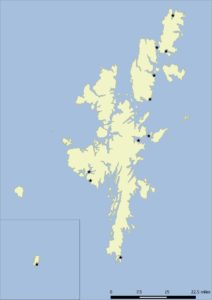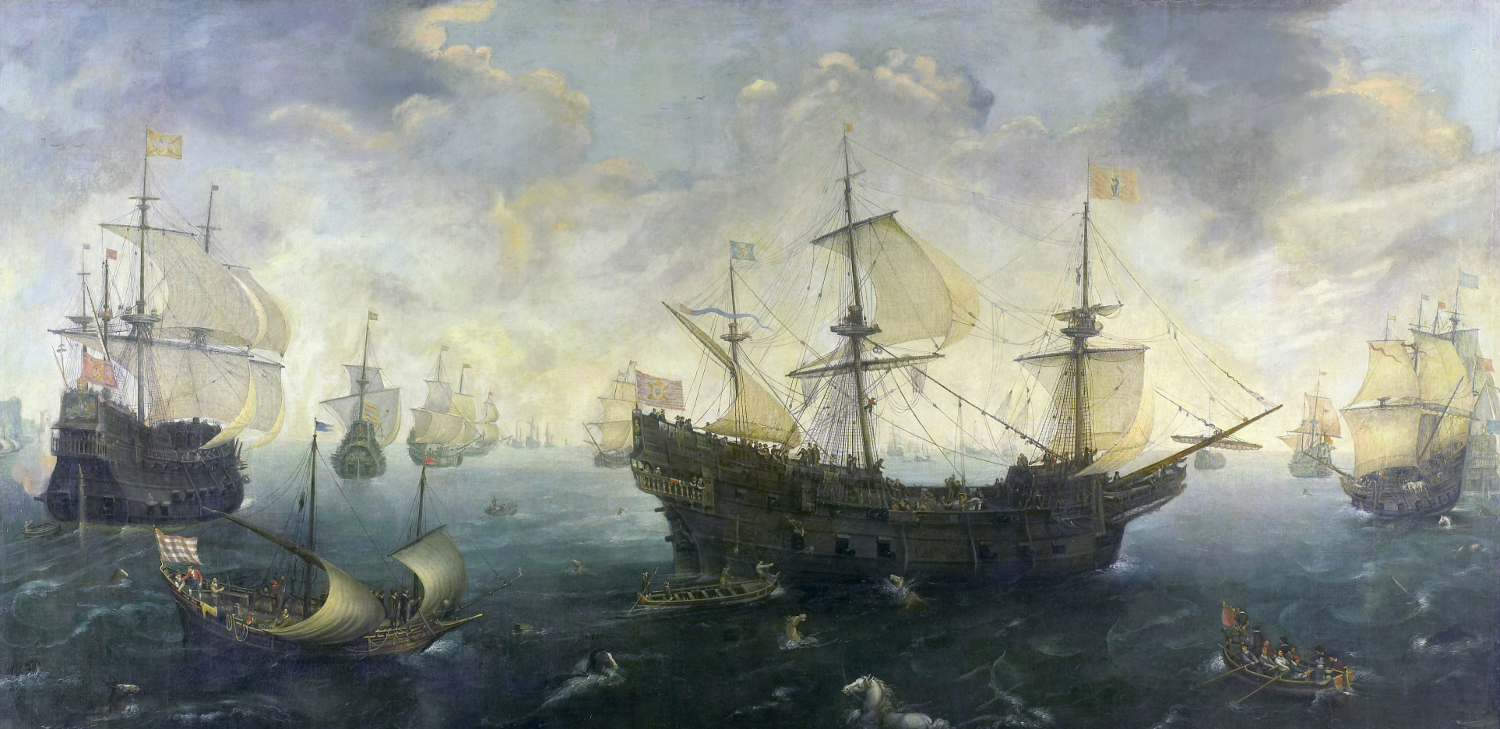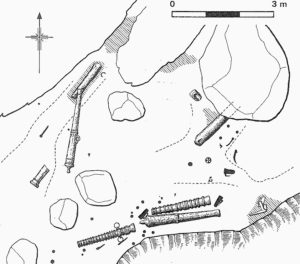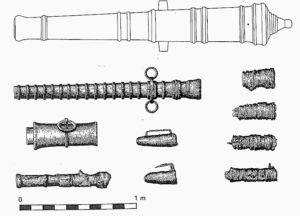El Gran Grífon – The story of a Hanseatic ship in the Spanish Armada, wrecked in Shetland
Philipp Grassel, 29 June 2017
In the 15th to 17th centuries, the North Atlantic Islands of Shetland, Faroe and Iceland were frequently visited by Hanseatic merchants, who usually made one voyage each year. The trading season started roughly in April and finished in August/September and because of its regular character, we have much information about the number of Hanseatic ships sailing North each year.

Map of the Shetland Islands with the positions of Hanseatic ship losses. Fair Isle and the wreck of the Gran Grífon can be seen in the smaller map (map created by P. Grassel)
In the middle of the 16th century, on average 5 ships per year from Bremen and 1 or 2 ships from Hamburg travelled to Shetland. Contemporary sources from 1560 speak of a minimum of 7 ships from Bremen and Hamburg in Shetland harbours. In Iceland, the numbers were even higher. For example in 1585, 14 ships from Hamburg alone and 8 ships from Bremen, Lübeck and Danzig reached Icelandic harbours, and in 1591 as many as 21 ships from Hamburg arrived in Iceland. In spite of these high numbers of voyages and some documented losses of Hanseatic ships – there are at least 10 known losses around Shetland and 3 losses around Iceland – no wrecks or remains of Hanseatic trading ships in the North Atlantic were found yet.
However, this does not mean that there are no Hanseatic trading vessels to be found in the North Atlantic at all. The only wreck which could be considered as Hanseatic are the remains of the El Gran Grífon (The great Griffin). This ship, which is the oldest known wreck both in Shetland and of all the North Atlantic islands, has a quite unusual history.
As the name already suggests, the Gran Grífon did not end up in Shetland by merchants from Bremen or Hamburg. Instead it was part of the famous Spanish Armada. This was a Spanish fleet which was sent in 1588 by the Spanish King Philipp II to invade England. The operation was a complete failure; the bulk of the fleet was lost after attacks by the English Navy and subsequent bad weather conditions on the North Sea.
The Gran Grífon itself was a former Hanseatic merchant vessel from Rostock, a Hansa Town in the Baltic Sea, and was bought by the Spanish Navy for the Armada. This was not unusual; merchant ships were in this time often converted for military use in times of war. After the ship had been roughly modified, it was used as the flagship for a squadron of 23 supply and troop ships. These poorly armed squadrons, called urca squadrons, consisted of acquired merchant vessels and were commanded by Juan Gomez de Medina. The ship had a tonnage of 650 tons, a length of around 30 m and an armament of 38 unspecified cannons. The original crew of 43 men were supplemented with around 200 soldiers. So all in all carried the ship over 243 men.
After some battles with the English Navy, which took the lives of over 40 soldiers and seamen, the ship was driven to the North of the British Isles. It was accompanied by other Armada vessels like the Barca de Amburgo (probably another converted Hanseatic ship from Hamburg), Castillo Negro and La Trinidad Valencera. After the Barca de Amburgo sank, the Gran Grífon and the Trinidad Valencera took over the surviving men.
Shortly afterwards the contact between the ships was lost and the Gran Grífon sailed in a South-West direction, trying to get back to Spain through the Atlantic. However, after the ship reached the latitude of the Galway Bay in Western Ireland, a strong gale from the South-West got up and flouted the Ship back North. Since the ship was heavily damaged, Juan Gomez de Medina decided to search for the nearest possible land. This turned out to be Fair Isle, the most southern and remote island of the Shetland archipelago. The ship tried to anchor in vain before it was driven ashore and ended up on a cliff at Stroms Hellier at the Southeastern end of the island in September 1588. Most of the remaining crew members and soldiers, including Gomez de Medina, managed to escape from the ship before it disappeared in the waves.
For a long time, the wreck remained untouched in the 9-18m deep water. In 1728, W. Irvine salvaged three cannons from the wreck. An archaeological excavation was carried out between 1970 and 1977 by the Institute of Maritime Archaeology of St Andrews University, led by C. Martin. Unfortunately the wreck was barely preserved. Parts of the stern, a rudder pintle, cannons of different sizes, coins, cannon balls, musket bullets and lead ingots were found, recorded and removed. Other, smaller finds like the handle of a pewter or “Hanseatic” flagon, as well as a curved iron blade, were also recovered. The wooden part of the stern was preserved under a boulder, which had tumbled down from the nearby cliff. Most of the finds were brought to Lerwick, where they can be partly seen at the Shetland Museum.
Further reading:
K. Friedland, Der hansische Shetlandhandel, in: K. Friedland, Stadt und Land in der Geschichte des Ostseeraums (Lübeck 1973) 66-79.
C. Martin, Cave of the Tide Race – El Gran Grifon, 1588, in: C. Martin, Scotland’s Historic Shipwrecks (London 1998) 28-45.
P. Grassel, Late Hanseatic seafaring from Hamburg and Bremen to the North Atlantic Islands. With a marine archaeological excursus in the Shetland Islands, Skyllis. Zeitschrift für marine und limnische Archäologie und Kulturgeschichte, 15.2, 2015, 172-182.


